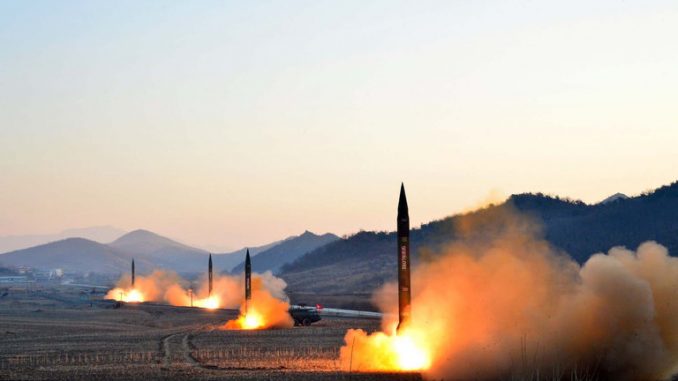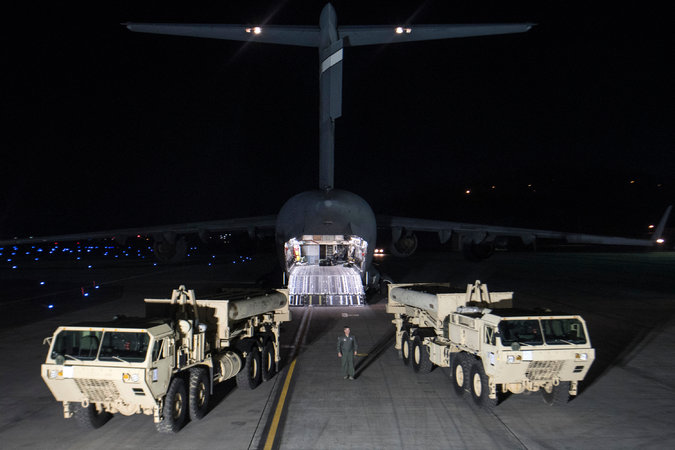
North Korea missiles & assassinations / Chinese anger over THAAD anti-missile deployment / Japanese & South Korean fears – balancing these would be difficult for anyone. For Trump and his “team” — at best, dangerously inexperienced and incompetent novices … at worst … – it’s nearly overwhelming. China says North should suspend its nuclear and missile activities — in exchange, South Korea and the US should suspend large-scale joint military exercises, laying groundwork for new negotiations with Kim regime. The Monday morning launch of North Korean missiles aimed at Japan. Credit: Korean Central News Agency
When the US began deploying a missile defense system in South Korea on Tuesday,
it was apparently to protect an ally long threatened by North Korean provocations.
But it was instantly met by angry Chinese warnings that the US is setting off a new arms race —
in a region already on edge over the North’s drive to build a nuclear arsenal, and destroy Kim Jong-un’s perceived enemies.
China condemned the new antimissile system as a dangerous opening move
in what it called America’s grand strategy to set up similar defenses across Asia,
threatening to tilt the balance of power there against Beijing.
These tensions are testing the new Trump administration and its uneasy allies South Korea and Japan,
which have complained for years that China has simultaneously chastised and coddled the North,
refusing to enact stiff enough measures to force it to abandon its nuclear and missile programs.
But with the beginning of work to install the antimissile system,
the delicate international cooperation against North Korea is splintering:
Beijing is expressing more concern about American intentions in the region
than about the dangers of the North’s latest surge in nuclear and missile testing.
The dual approach seemed evident on Wednesday when China’s foreign minister, Wang Yi, said,
“The two sides are like two accelerating trains coming toward each other, and neither side is willing to give way.”
“Our priority now is to flash the red light and apply brakes,” Wang said at a news conference in Beijing.
He said North Korea should suspend its nuclear and missile activities and that,
in exchange, South Korea and the US should suspend large-scale joint military exercises,
laying the groundwork for new negotiations with North Korea.
President Trump got personally engaged in the problem on Monday night,
after North Korea launched four ballistic missiles, aimed toward Japan,
that the North Koreans later described as practice for hitting American bases there.
Japan’s prime minister, Shinzo Abe, said he spoke with Trump for 25 minutes, adding,
“I appreciate that the US is showing that all the options are on the table”–
usually code words for raising the possibility of a military response.
To conservatives in South Korea’s crisis-racked government,
the antimissile system is exactly the kind of strong action needed to counter the North’s belligerence
and demonstrate unity with Trump, who had suggested during the campaign
that Asian nations needed to do far more to defend themselves.
But South Korea remains deeply divided about the one response already underway:
the deployment of the Terminal High Altitude Area Defense System, or THAAD.
It is designed to intercept short- and medium-range missiles,
but not the kind of intercontinental missiles the North says it is developing to reach the US.
Many South Koreans oppose it and worry about China’s moves to block South Korean imports,
due to Beijing’s continued insistence that THAAD is aimed at containing Chinese power —
not the missile capabilities of Kim Jong-un, the North Korean leader.
Japan is urging stronger American action, but remains uncertain about how much it wants to commit,
when a conflict with the North — deliberate or accidental — once again looks like a real possibility for the first time since the late 1940s.
The combination of military and diplomatic tensions suddenly unleashed in Asia
comes before Trump’s full national security team is in place —
and before it has any well-thought-out strategy, either regionally or globally.
Secretary of State Rex W. Tillerson, who will travel to the region next week — stopping in Tokyo; Seoul, South Korea; and Beijing —
has never dealt with a proliferation problem like this one,
his only “diplomatic” experience being negotiations, as head of ExxonMobil, with Trump “pal” Vladimir Putin.
Defense Secretary Jim Mattis has already been to Seoul on one visit,
but was there mostly to reassure the country that, despite Trump’s statements last year,
the United States remains committed to its defense.
The new national security adviser, Lt. Gen. H. R. McMaster, has focused more on counterinsurgency in the Muslim world
than dealing with the peculiar problem of a nuclear-armed failing state.
In three meetings at the White House — more than on any other foreign policy problem —
the National Security Council deputies have considered a range of options,
and have already come to the predictable conclusion that
a dramatic show of force, like attacks on the North’s missile and nuclear sites, would probably start a war.
The New York Times reported this weekend that the Obama administration had created a cyber- and electronic-warfare program to slow the North’s missile tests,
but that it was unclear how effective it had been, particularly in recent months.
The North Koreans have made the most of this period of uncertainty and transition.
Their sped-up testing seems intended to send a message that they can overwhelm antimissile defenses,
deploying missiles faster than the US and its allies can put countermeasures in place.
And they hold an ace card:
an ability to destroy Seoul with artillery buried in the mountains just north of the Demilitarized Zone,
a remnant of the Korean War.
Equipment for a missile defense system arriving at an air base in South Korea on Monday. Credit U.S. Forces Korea, via Associated Press
In the North’s view, the American rush to put missile defenses around it only splits the global community,
pushing China and Russia closer to Pyongyang, as American officials acknowledge when speaking on the condition of anonymity.
Tillerson is focused on ways to pressure China, while trying to set up a first meeting between President Xi Jinping and Trump.
But the two nations’ leaders are each conducting a balancing act.
Xi’s is the hardest, trying to weigh his opposition to Kim’s nuclear program
against his conviction that a North Korean collapse would be far worse —
creating the possibility of a flood of millions of hungry, poorly-educated refugees.
The Trump administration is measuring how hard it can press Beijing.
It is mulling negotiations to “freeze” the North’s nuclear arsenal —
but that would also acknowledge it as a fact.
“You may not want to acknowledge that North Korea has 12 or 20 weapons,”
said Robert Litwak of the Woodrow Wilson Center for International Scholars,
the author of the new study “Preventing North Korea’s Nuclear Breakout,”
“but wouldn’t a freeze be better than looking at 100 weapons a few years from now?”
That is exactly the debate taking place in the White House, as Trump’s aides try to figure out their alternatives,
including changing the security landscape with a major military buildup
or, if needed, an open conflict with North Korea.
The current, slow-burning crisis arose not from one episode, but from Kim’s broader strategy over the past year:
to accelerate the pace of nuclear and missile tests so his arsenal becomes a fait accompli,
something the United States cannot hope to reverse.
When North Korea launched four Scud-ER ballistic missiles on Monday,
it tried to demonstrate an ability to simultaneously launch multiple missiles at American bases in Japan
AND at American aircraft carriers around the Korean Peninsula,
South Korean military officials said Tuesday.
The ability to launch a barrage of missiles increases the chances of breaching an antimissile shield.
But the types of midrange missiles North Korea has launched in recent months —
including the Scud-ERs, with a 620-mile range —
pose another problem for South Korea.
Some of the missiles have been launched at a steep angle
to achieve a higher altitude and return to earth at high speed,
techniques that appear intended to complicate intercepting them.
American military officials said the recent tests were a particular concern because
they illustrated Pyongyang’s ability to carry out a salvo of launches — and on very short notice.
“What we saw this weekend was demonstration of a near-term simultaneous launch,”
said Vice Adm. James D. Syring, the director of the Pentagon’s Missile Defense Agency.
“That is something beyond what we have seen in the past.”
For Washington and Seoul, the rush to field THAAD is as much about politics as missile interception.
American officials have repeatedly warned China that failure to rein in North Korea’s nuclear and missile programs
would force the United States to deploy missile defenses in the region.
Seoul’s right-wing interim government wants to deploy the antimissile system
before any opposition progressive leader — skeptical of the deployment — can take power in a coming presidential election.
But the opposition progressives have deeply-held reservations about the THAAD deployment,
seeing it as part of the US effort to wrap the South into an anti-China coalition and arms race.
They have already mounted a case against it.
On Tuesday, Woo Sang-ho, the floor leader of the main opposition Democratic Party, warned,
“Our business are dying; our people residing in China are being threatened.”
Hong Ik-pyo, a senior policy maker in the opposition, said
the THAAD deployment would do more harm than good for South Korea,
whose economy depends on exports for growth,
and reaps a huge annual trade surplus with China.
“They say this is only to defend us from North Korea,
but everyone knows this is part of the American missile defense plan,” Hong said.
“China sees the THAAD deployment in South Korea the way Americans saw the Cuban missile crisis in the 1960s.”
The Chinese government said Tuesday that it continued to oppose the deployment of THAAD.
Chinese leaders have also struggled to grapple with the unpredictable styles of both Kim and Trump.
Now there are fears the North might take advantage of the political discord to move ahead with its nuclear weapons program.
“They have seized this opportunity, knowing the US and China are clashing,”
said Cheng Xiaohe, an associate professor of international studies at Renmin University in Beijing.
In recent weeks, China has toughened its stance on North Korea, including banning imports of coal from the North.
Criticism of the North has also sharpened.
On Tuesday, a state-run newspaper warned that North Korea should give up its weapons or “face long-lasting isolation and pressure.”
Yet policy makers in Beijing seemingly fail to grasp
how Washington and its allies regarded North Korea’s nuclear program as getting closer to a dangerous threshold —
being able to place a warhead on an intercontinental ballistic missile,
said Paul Haenle, the director of the Carnegie-Tsinghua Center at Tsinghua University in Beijing.
“That’s a game-changer,” he added.
Source: North Korea Tensions Pose Early, and Perilous, Test for Trump – The New York Times
